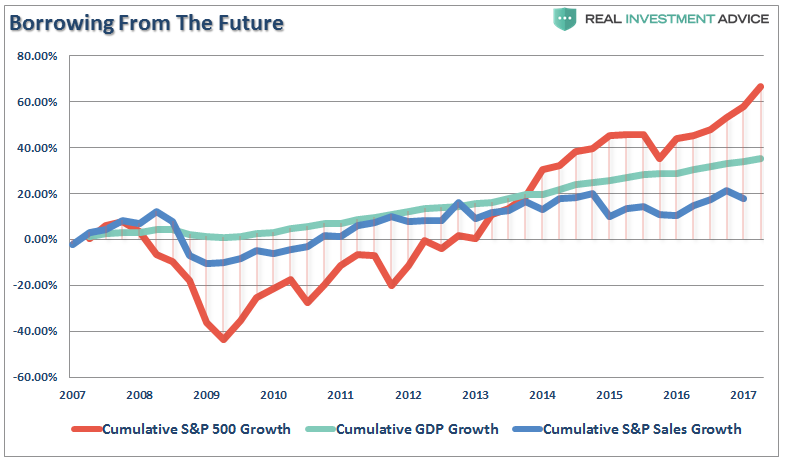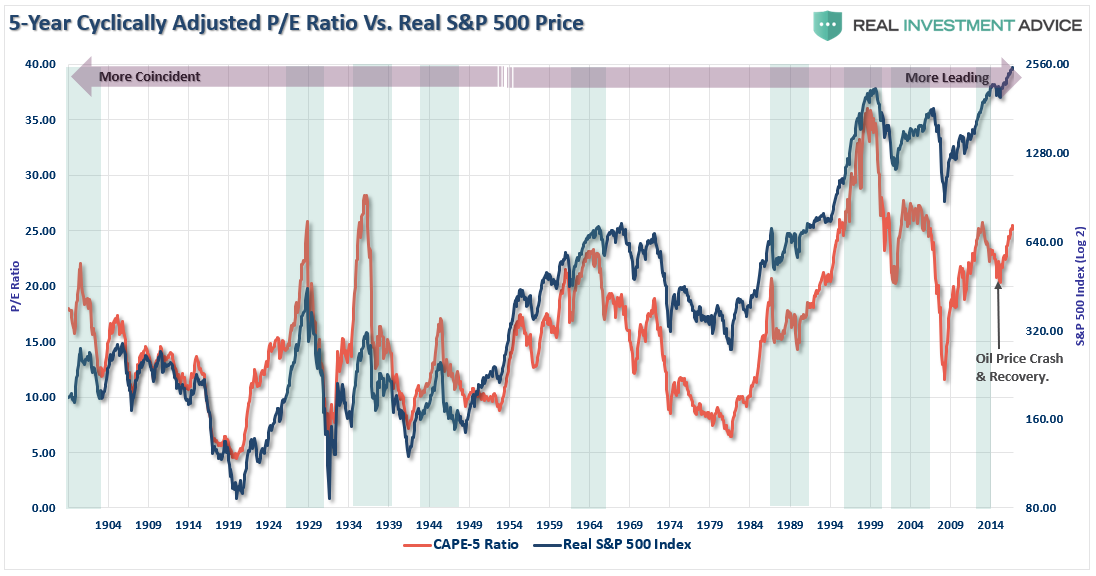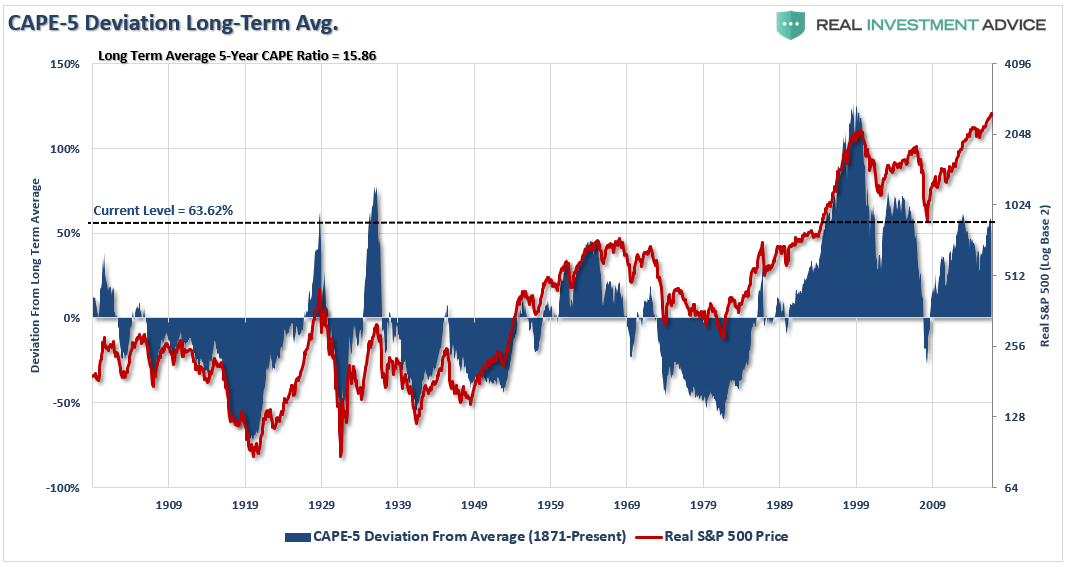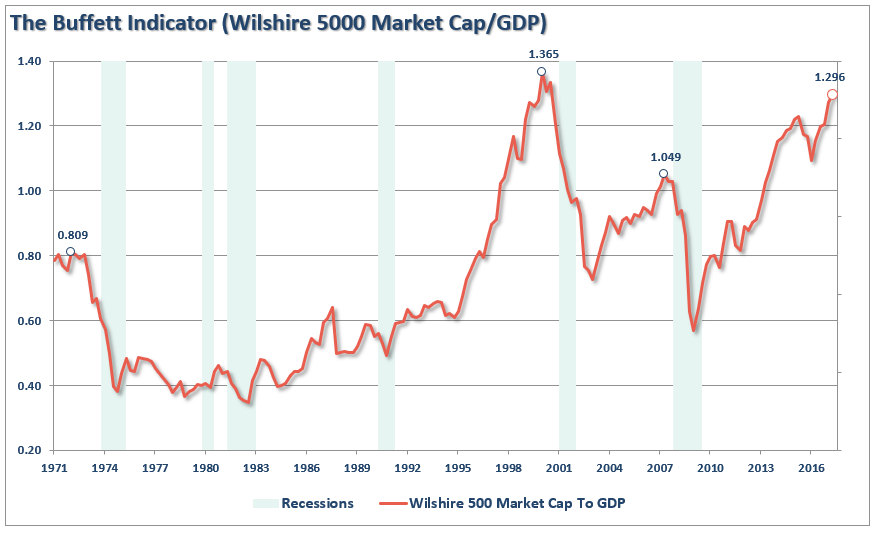Authored by Lance Roberts via RealInvestmentAdvice.com,

During my morning reading, I ran across a couple of very interesting articles that tied a common theme relating to the current risks in the financial markets.
Via Zerohedge:
88-year-old investing icon John “Jack” Bogle, founder of the Vanguard Group, said:
“The valuations of stocks are, by my standards, rather high, but my standards, however, are high.
When considering stock valuations, Bogle’s method differs from Wall Street’s. For his price-to-earnings multiple, Bogle uses the past 12 months of reported earnings by corporations, GAAP earnings, which include ‘all of the bad stuff,’ to get a multiple of about 25 or 26 times earnings.
‘Wall Street will have none of that. They look ahead to the earnings for the next 12 months and we don’t really know what they are so it’s a little gamble.’
He also noted that Wall Street analysts look at operating earnings, ‘earnings without all that bad stuff,’ and come up with a price-to-earnings multiple of something in the range of 17 or 18.
‘If you believe the way we look at it, much more realistically I think, the P/E is relatively high,’
‘I believe strongly that [investors] should be realizing valuations are fairly full, and if they are nervous they could easily sell off a portion of their stocks.’”
This, of course, from the father of “buy and hold” investing with whom millions of Americans have pumped roughly $4.7 Trillion into a whole smörgåsbord of indexed based ETF’s provided by Vanguard to meet investor appetites.
Think about that for a moment while you read the following snippet from Bloomberg:
“A buoyant and complacent stock market is worrying Richard H. Thaler, the University of Chicago professor who this week won the Nobel Prize in economics.
‘We seem to be living in the riskiest moment of our lives, and yet the stock market seems to be napping. I admit to not understanding it.
I don’t know about you, but I’m nervous, and it seems like when investors are nervous, they’re prone to being spooked. Nothing seems to spook the market, and if the gains are based on tax-reform expectations, surely investors should have lost confidence that tax reform is going to happen.’”
These two points drive to the heart of the recent concerns I have expressed in both how companies continue to use accounting gimmickry to win the “beat the estimate game” each quarter and the risk of disappointment surrounding tax reform legislation.
But since markets have continued to advance due to the ongoing flood of liquidity from global Central Banks, no one is really paying attention to such “silly” things. However, while market analysts continue to come up with a variety of rationalizations to justify high valuations, none of them hold up under real scrutiny. The problem is the Central Bank interventions boost asset prices in the short-term, in the long-term, there is an inherently negative impact on economic growth. As such, it leads to the repetitive cycle of monetary policy.
- Using monetary policy to drag forward future consumption leaves a larger void in the future that must be continually refilled.
- Monetary policy does not create self-sustaining economic growth and therefore requires ever larger amounts of monetary policy to maintain the same level of activity.
- The filling of the “gap” between fundamentals and reality leads to consumer contraction and ultimately a recession as economic activity recedes.
- Job losses rise, wealth effect diminishes and real wealth is destroyed.
- Middle class shrinks further.
- Central banks act to provide more liquidity to offset recessionary drag and restart economic growth by dragging forward future consumption.
- Wash, Rinse, Repeat.
If you don’t believe me, here is the evidence.
The stock market has returned more than 60% since 2007 peak, which is more than three times the growth in corporate sales growth and 30% more than GDP. The all-time highs in the stock market have been driven by the $4.5 trillion increase in the Fed’s balance sheet, hundreds of billions in stock buybacks, PE expansion, and ZIRP.

It is critical to remember the stock market is NOT the economy. The stock market should be reflective of underlying economic growth which drives actual revenue growth. Furthermore, GDP growth and stock returns are not highly correlated. In fact, some analysis suggests that they are negatively correlated and perhaps fairly strongly so (-0.40).
However, in the meantime, the promise of a continued bull market is very enticing as the “fear of missing out”overrides the “fear of loss.”
Valuations Are Expensive
This brings us back to Jack Bogle and the importance of valuations which are often dismissed in the short-term because there is not an immediate impact on price returns. Valuations, by their very nature, are HORRIBLE predictors of 12-month returns should not be used in any strategy that has such a focus. However, in the longer term, valuations are strong predictors of expected returns.
I have adjusted Bogle’s measure of valuations to a 24-month, versus 12-month, measure to smooth out the enormous spike in valuations due to the earnings collapse in 2008. The end valuation result is the same but peaks, and troughs, in valuations are more clearly shown.

At 26.81, Bogle is clearly correct that valuations have reached expensive levels. More importantly, outside of the peak in 1999, stocks are more highly valued today than at any other point in history. (The two points during bear market troughs are excluded as those valuations were due to earnings collapsing faster than prices due to recessionary conditions.)
Bogle’s view is also confirmed by other measures as well. The chart below shows Dr. Robert Shiller’s cyclically adjusted P/E ratio combined with Tobin’s Q-ratio. Again, valuations only appear cheap when compared to the peak in 2000. Outside of that exception, the financial markets are now more expensive than at any other single point in history.

I have also previously modified Shiller’s CAPE to make it more sensitive to current market dynamics.
“The need to smooth earnings volatility is necessary to get a better understanding of what the underlying trend of valuations actually is. For investor’s, periods of ‘valuation expansion’ are where the bulk of the gains in the financial markets have been made over the last 116 years. History shows, that during periods of ‘valuation compression’ returns are more muted and volatile.
Therefore, in order to compensate for the potential ‘duration mismatch’ of a faster moving market environment, I recalculated the CAPE ratio using a 5-year average as shown in the chart below.”

To get a better understanding of where valuations are currently relative to past history, we can look at the deviation between current valuation levels and the long-term average going back to 1900.

With a 63.62% deviation from the long-term mean, a reversion will be quite damaging to investors when it occurs. As you will notice, reversions have NEVER resulted in a “sideways” consolidation but rather much more serious, and sharp, declines. These rapid “maulings” of investors is why declines are aptly named “bear markets.”
Lastly, even Warren Buffett’s favorite valuation measure is screaming valuation issues. The following measure is the price of the Wilshire 5000 market capitalization level divided by GDP. Again, as noted above, asset prices should be reflective of underlying economic growth rather than the “irrational exuberance” of investors.

Of course, it’s Buffett’s own axiom that best sums up all of the famous valuation measures noted above.
“Price is what you pay, valuation is what you get.”
Maybe Not Today
Bogle, Buffett, Shiller, and Tobin are right about valuations.
Maybe not today.
Next month.
Or even next year.
But as Vitaliy Katsenelson just recently penned:
“Our goal is to win a war, and to do that we may need to lose a few battles in the interim.
Yes, we want to make money, but it is even more important not to lose it. If the market continues to mount even higher, we will likely lag behind. The stocks we own will become fully valued, and we’ll sell them. If our cash balances continue to rise, then they will. We are not going to sacrifice our standards and thus let our portfolio be a byproduct of forced or irrational decisions.
We are willing to lose a few battles, but those losses will be necessary to win the war. Timing the market is an impossible endeavor. We don’t know anyone who has done it successfully on a consistent and repeated basis. In the short run, stock market movements are completely random – as random as you’re trying to guess the next card at the blackjack table.”
With that point, I clearly agree.